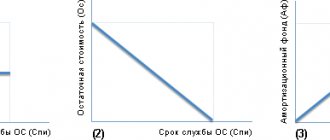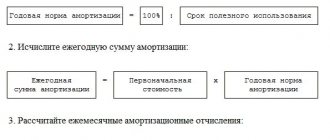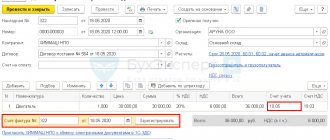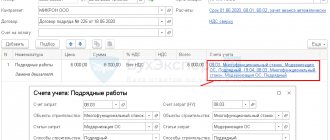(published in the magazine “Chairman of the HOA” No. 1 (75) 2014)
Owners of premises in apartment buildings managed by HOAs and housing cooperatives can use one of two methods to form a capital repair fund:
— transfer of contributions for major repairs to a special account. In this case, the owners of the special account, as a rule, become the HOAs and housing cooperatives themselves;
— transfer of contributions for major repairs to the account of the regional operator.
In houses managed by management organizations, only the second method is used.
In table 1 shows accounting transactions that can be performed using a special account.
In table 2 shows accounting transactions when using a regional operator account.
Using a special account
Business transaction
Debit
Credit
Norm of the Housing Code of the Russian Federation
1. Monthly contributions to the capital repair fund have been accrued to the owners
2. Interest (penalties) were accrued to the owners in connection with improper fulfillment of the obligation to pay contributions
3. Part of the owners’ debt is covered by retained earnings
4. Part of the profit is transferred to a special account in accordance with clause 3
5. Owner contributions were transferred to a special account
6. The special account received the interest (penalties) accrued in clause 2
7. The capital repair fund received bank interest for using funds from a special account
8. Funds were received from the budget as a measure of state support for capital repairs
9. A loan (loan) was received due to a lack of funds in the capital repair fund
10. Due to future contributions from the owners, the capital repair fund has been increased to cover the loan (loan)
11. A reserve has been created to finance capital repairs in accordance with the repair estimate
12. Accrued to the contractor for the execution of major repairs
13. Transferred to the contractor for the execution of major repairs
14. The special account received contributions from the owners sufficient to cover the debt under clause 9
15. The loan debt has been paid from a special account.
16. Funds were transferred to the account of the regional operator when changing the method of forming the capital repair fund
17. Funds received from the regional operator are credited to a special account when the method of forming the capital repair fund changes
18. Commission remuneration was written off in accordance with the terms of the special account agreement
19. Funds were transferred from a special account in the cases provided for in Part 2 of Art. 174 Housing Code of the Russian Federation
In accordance with paragraph 2 of Art. 251 of the Tax Code of the Russian Federation, funds received by a homeowners’ association or housing cooperative for the formation of a reserve for major repairs of common property represent targeted revenues. Therefore, in Table. 1, these funds are reflected in the credit of account 86 “Targeted financing” by type of income.
The movement of funds in a special account is reflected using account 55 “Special accounts in banks”.
Account 76-2 (operation 10) is used to increase the capital repair fund, reflected in the credit of account 86-3, at the expense of accounts receivable - future contributions from the owners in the event of receiving a credit (loan) necessary for capital repairs.
The amount of funds intended to finance specific capital repairs according to the estimate under the contract is accumulated under the credit of account 96 “Reserves for future expenses” by debiting each of the subaccounts of account 86 “Targeted financing” in proportion to the balances on these subaccounts.
In accordance with the norm of Part 2 of Art. 177 receipts reflected in paragraphs. Tables 6 and 7 1, do not form an object of taxation.
If the HOA has been created in several apartment buildings, then, according to Part 4 of Art. 175 of the Housing Code of the Russian Federation, for each house a separate special account must be opened in the bank, and in accounting for account 55 “Special accounts in banks” - a separate sub-account.
Transactions in the accounting of homeowners' associations (housing cooperatives) and management organizations when using a regional operator account
Business transaction
Debit
Credit
Norm of the Housing Code of the Russian Federation
1. Monthly contributions to the capital repair fund have been accrued to the owners
2. Part of the owners’ debt is covered by the retained profits of the HOA (housing cooperative)
Read more: How long does the Social Insurance Fund pay for sick leave?
3. The transfer of contributions by the owners to the regional operator is reflected
4. Part of the profit for the case of clause 2 is transferred to the regional operator
When using a regional operator's account, monthly contributions for major repairs are received from the owners of premises in an apartment building directly to the account of the regional operator (bypassing the accounts of the HOA, housing cooperative, and management organization). For this reason, in Table. 2 there are no operations similar to operation 5 in table. 1. But HOAs, housing cooperatives, and management organizations must control the processes of calculation and payment of contributions by owners of premises in houses under their management. For this purpose, the accounting departments of HOAs, housing cooperatives and management organizations must receive information about the accrual and actual payment of contributions (operations 1 and 3 of Table 2). The credit balance in account 76-2 reflects the debt of the owners to pay contributions. Operations 2 and 4 appear if the HOA, housing cooperative or management organization has the opportunity to cover part of the owners’ debt using existing income from renting out common property in an apartment building or other income.
The subaccount numbers in the tables are conditional. The accountant has the right to set subaccount numbers in accordance with the working chart of accounts adopted in the accounting policy of the organization.
Postings in HOAs - basic examples
All decisions made regarding common property are approved at a general meeting of homeowners by a majority vote. To determine the number of votes that the owner of a residential premises has, it is necessary to take into account his share in the ownership of the common property.
Modern practice shows that one of the most effective ways to manage an apartment building is an HOA. The organization of an established system for accounting for HOA operations is a prerequisite necessary to ensure the full functioning of the partnership and the fulfillment of its main tasks. In the article we will analyze specific aspects of accounting for HOAs and consider typical accounting entries in HOA enterprises using examples.
Account of wiring for major repairs in a homeowners' association
Cash receipts that are subject to and non-taxable must be accounted for separately. It is also important to ensure separate accounting of expenditures of funds received as targeted revenues. Therefore, the priority areas of work for an HOA accountant include drawing up cost estimates and distribution of costs, organizing analytical accounting of the organization’s costs.
- Receipt of invoice 86 credit of invoice 70 “Settlements with personnel for wages” - salaries to employees.
- Receipt of account 50 “Cash” debt of account 51 – receipt of money from the bank.
- Receipt of nominal account 10 “Materials” credit of account 50 – purchase of household supplies for cash.
Formation of authorized capital in 1C 8.3 with postings
10/24/2018 When the founders register an LLC, they need to contribute the authorized capital.
This can be either cash or property. It is the authorized capital that determines the minimum amount of the organization’s property that guarantees the interests of creditors. In this article we will look at step-by-step instructions and transactions for forming authorized capital in 1C 8.3 and making contributions through a cash register/current account.
In the 1C 8.3 Accounting program, prior to release version 3.0.46, there was no special document to reflect the contribution of the authorized capital. Therefore, wiring must be done manually. Go to the "Operations" menu and select "Manually entered operations".
In the list form that opens, click on the “Create” button and select “Operation”. Let's take a closer look at what transactions need to be created in 1C.
Account of wiring for major repairs in a homeowners' association
The HOA keeps records of targeted funds in account 86 “Targeted Financing”. For account 86, it is necessary to open sub-accounts based on the sources of funds received. Let's consider the accounting of HOA fees, except for payments for housing and communal services, the accounting of which will be discussed below.
It is important to note that the partnership is obliged to ensure the maintenance of the common property of the apartment building as a whole, regardless of whether the share of such property belongs to a member of the HOA (TSN) or not. Consequently, in order to ensure the fulfillment of such an obligation in relation to the owners of premises who are not members of the HOA (TSN), the partnership must separately enter into an agreement with each of them for the maintenance and repair of common property in an apartment building.
Composition of the common property of an apartment building
The common property of an apartment building (the repair of which is provided by the management company) includes, in particular:
- inter-apartment landings, stairs;
- elevators, elevators and other shafts;
- corridors;
- technical floors;
- attics;
- basements with utility lines;
- other equipment serving more than one room in a given house (technical basements):
– roofs enclosing load-bearing and non-load-bearing structures of the house;
– mechanical, electrical, sanitary and other equipment serving more than one room.
A complete list of common property is given in Section I of the Rules, approved by Decree of the Government of the Russian Federation of August 13, 2006 No. 491.
The form for describing the composition and technical condition of common property is given in Appendix 1 to the approximate conditions approved by Order of the Ministry of Construction of Russia dated July 31, 2014 No. 411/pr. The form is not mandatory; the owners of the premises of an apartment building have the right to determine a specific list of common property independently and draw it up in any form (letter of the Ministry of Regional Development of Russia dated April 4, 2007 No. 6037-RM/07).
Account of wiring for repairs from capital repairs in the homeowners association
Debit 60 Credit 51 (55) – payment was transferred to a third-party contractor performing repairs; Debit 20 Credit 60 – expenses for repairs performed by third-party contractors are reflected; Debit 19 Credit 60 – input VAT presented by contractors is taken into account; Debit 20 Credit 19 – the amount of VAT claimed by contractors is attributed to the costs of repairs carried out by contract; Debit 20 Credit 70 (69, 10...) – reflects the costs of repairs carried out by the homeowners association (TSN) on their own; Debit 86 Credit 20 – reflects the expenditure of targeted financing; Debit 86 Credit 68 subaccount “Calculations for VAT” – VAT is charged for repair work carried out by the HOA (TSN) on its own.
Entry, membership, share fees, donations, and funds in reserve for repairs are not subject to taxation. Tax accounting of amounts received as income in HOAs is no different from accounting in other organizations engaged in commercial activities.
How are reports generated and submitted?
Accounting in HOAs requires the mandatory generation of reports that must be submitted both to the Federal Tax Service and to statistical authorities and extra-budgetary funds. Accounting statements in such partnerships are prepared for the year (even if the HOA does not carry out commercial activities and is on the simplified tax system), and includes:
- Balance.
- Report on the intended use of funds.
- Register of members of the partnership.
- Income statement.
In addition to accounting reports, the partnership must submit the following forms related to the calculation and payment of wages:
| Federal Tax Service | Form 6-NDFL Form 2-NDFL Average number of employees |
| Pension Fund | Form SZV-M Form RSV-1 |
| FSS | Form 4-FSS |
If the activities of the HOA are carried out on a simplified basis, then it is necessary to submit a corresponding declaration to the Federal Tax Service. It is worth noting that HOAs under the simplified tax system are exempt from paying the following taxes:
- at a profit;
- on property;
- VAT.
Taxation under the simplified tax system provides for the opportunity for a partnership to independently determine its own rate:
- A 6% rate is applied to income.
- A rate of 15% is applied to the difference between income and expenses.
The HOA on OSNO is obliged to accrue and pay to the budget all taxes and fees provided for by law, as well as submit the relevant declarations to the regulatory authorities. For late submission of reports, the responsible persons of the partnership will be subject to penalties and interest.
Accounting for capital repairs in HOAs
The costs of major repairs cannot be recognized for the purposes of calculating the tax paid when applying the simplification, since they were incurred at the expense of targeted financing. At the same time, the organization is obliged to keep separate records of such income and expenses (clause 14, clause 1, article 251, clause 2, article 346.16, clause 1, article 252 of the Tax Code of the Russian Federation).
- account 86-2 “Targeted revenues for current repairs of common property”;
- account 86-3 “Targeted revenues for major repairs of common property”;
- account 86-3-1 “Targeted revenues for major repairs of common property from owners”;
- account 86-3-1 “Targeted revenues for major repairs of common property from the budget.”
Read more: Utility bills and operating costs
Accounting: receipt of financing
Regardless of whether the repair is current or major, reflect the receipt of funds for it in accounting depending on the source of financing.
If the repairs are co-financed by budget funds, make the following entries in accounting:
Debit 76 Credit 86 – reflects the budget debt (the amount of allocated budget funds);
Debit 55 Credit 76 – funds received for repairs from the budget.
This conclusion follows from paragraph 7 of PBU 13/2000 and the Instructions for the chart of accounts.
Reflect funds for repairs received from owners and tenants of premises as part of advances:
Debit 51 Credit 62 “Settlements for advances received” - funds for repairs were received from the owner (tenant) of the premises.
This follows from the Instructions for the chart of accounts and paragraph 3 of PBU 9/99.
Reflect funds for repairs received from the regional operator as follows:
Debit 51 Credit 62 “Settlements for advances received” – an advance for repairs was received from a regional operator;
Debit 51 Credit 62 “Settlements with regional operator” – funds received for repairs from the regional operator.
This follows from the Instructions for the chart of accounts and paragraph 3 of PBU 9/99.
Taxation of HOAs under the simplified tax system in 2019
- mandatory payments, entrance and other fees of HOA members;
- payments from homeowners who are not members of the HOA;
- income from the entrepreneurial activities of the HOA, aimed at fulfilling the goals, objectives and responsibilities of the HOA (Article 152 of the Housing Code of the Russian Federation);
- subsidies for the operation of common property, carrying out current and major repairs, providing certain types of utilities and other subsidies;
- other supply.
The HOA keeps records of targeted funds in account 86 “Targeted Financing”. For account 86, it is necessary to open sub-accounts based on the sources of funds received. Let's consider the accounting of HOA fees, except for payments for housing and communal services, the accounting of which will be discussed below.
Book of Postings for Overhaul in Homeowners' Association
Account 76-2 (operation 10) is used to increase the capital repair fund, reflected in the credit of account 86-3, at the expense of accounts receivable - future contributions from the owners in the event of receiving a credit (loan) necessary for capital repairs.
In accordance with paragraph 2 of Art. 251 of the Tax Code of the Russian Federation, funds received by a homeowners’ association or housing cooperative for the formation of a reserve for major repairs of common property represent targeted revenues. Therefore, in Table. 1, these funds are reflected in the credit of account 86 “Targeted financing” by type of income.
Goals and objectives of a non-profit organization - HOA
Homeowners' associations - HOAs - are traditionally created in urban environments, in apartment buildings.
However, situations are possible when owners of private residential buildings united on some basis (for example, occupying neighboring land plots in a populated area) also unite in an HOA. The main purpose of such an association is the effective joint management of residential real estate belonging to the partners.
Realization of the goal sets the following main tasks for the HOA participants:
- maintenance of HOA property;
- repair of HOA property;
- creating comfortable living conditions and use of property for all owners.
In addition to the main goals that determine the non-commercial orientation of the HOA's activities (comrades conduct activities for themselves), situations are possible when the HOA generates income. For example:
- receives remuneration for placing advertising on the building, for using the property to provide Internet services, cable television, commercial telephony, etc.;
- leases non-residential premises related to the property;
- provides paid services to residents (for example, minor repairs in apartments).
Find out how to create an HOA in ConsultantPlus. Study the material by getting trial access to the K+ system for free.
Accounting and tax accounting in HOAs (TSN): postings, documents, benefits
It is necessary to pay attention to the procedure for accounting for utility payments received from the owners of premises when applying the simplified tax system in the partnership. The organization's charter may stipulate its obligation to provide such services to its members and enter into contracts with suppliers on their behalf.
Money received as membership or other fees does not form the partnership’s income and is used to pay for utilities and maintain housing in proper condition. When carrying out activities and concluding contracts, the HOA must act only in the interests of home owners.
The procedure for generating funds
Accounting in an HOA involves recording all transactions that are directly or indirectly related to the partnership. The specialist who will be entrusted with accounting is required to draw up primary documentation, the data from which must be posted to the appropriate registers.
When organizing accounting in a partnership, incoming funds from which capital is formed must be registered in a separate accounting register:
- contributions for major repairs;
- receipts in the form of entrance and membership fees;
- penalties for late paid utilities (the full amount of rent is not included);
- subsidies;
- the difference between received utility payments and their actual cost;
- income received while conducting commercial activities, etc.
Accounting for contributions for major repairs
The Capital Repair Fund is created through contributions from real estate owners. Its purpose is to reserve funds for expensive repairs in the future. Contributions are transferred by the owners of premises located in apartment buildings on a monthly basis (Part 1 of Article 169 of the Housing Code of the Russian Federation).
- D76 – K96 – monthly accrual of contributions to the capital repair fund to the owners;
- D55 – K76 – monthly receipts of contributions for major repairs from the owners;
- D96 – K60 – 55 million rubles, the cost of repairs that will be carried out by the contracting structure;
- D60 – K51 (55) – payment for the contractor’s services was made (RUB 55 million);
- the balance of funds in the fund (account 96) amounted to 500.6 million rubles. (555.6 – 55).
Benefits of a special account
When all the owners are ready to pay, and the house is not included in the list of works of the management company or HOA for the near future, opening a special account has the most advantages in comparison with other methods of raising funds for major repairs. After its creation, residents of the house will be able to immediately begin accumulating money on it and independently set the timing and details of the overhaul.
All funds collected will be spent only on their home, while from the general fund they will first go to work in other people's homes. Only the residents themselves will also manage the funds, and even if the HOA is declared bankrupt, the amount accumulated in the special account will remain untouchable .
Features of accounting in HOAs
- The “Income” object is very simple, but you just need to correctly take into account all profits and record insurance premiums and sick leave in order to reduce taxes to 50%.
- “Income – expenses” is already more difficult for tax accounting, but it is more profitable if the partnership has more expenses than profits. Then the HOA will pay only 1% of the profit.
- Receipt of account 76 “Settlements with various creditors and debtors” subsection “Settlements with residents” credit of account 86 “Targeted financing” - payment by residents of membership fees (aka rent).
- Receipt of nominal account 76 sub-account “Settlements with tenants” credit of account 76 sub-account “Settlements for utility bills” – calculation of payment for utility bills.
Basic rules for accounting in HOAs (nuances)
In accordance with the plan and provisions of PBU 9/99 (approved by order of the Ministry of Finance dated 05/06/1999 No. 32n) and PBU 10/99 (approved by order of the Ministry of Finance dated 05/06/1999 No. 33n), accounting for contributions from partners for the implementation of activities is kept in account 86 , and receipts from income-generating activities are in account 90.
Read more: Medical report Appendix 3 to Order 297
One of the main tasks is the generation of a financial report (usually for the year), which provides partners with complete and reliable information about the activities of the HOA. In addition, the HOA accounting department prepares an estimate of the HOA's income and expenses for the next year. The estimate is approved at the general meeting of the partners and in the future is the main planning and accounting document for maintaining the accounting of the HOA.
The Accounting Methodological Center (AMC) has prepared recommendations for accounting for the costs of major repairs of fixed assets.
Timely repairs are one of the conditions for the normal functioning of a fixed asset facility. With a one-time write-off of the costs of major repairs to the cost of production, the enterprise is faced with the problem of a sharp increase in the costs of the current period. However, the fact of repairs, other things being equal, cannot be considered as an objective reason for the increase in the cost of products produced during the period of these activities, since these costs determine the receipt of economic benefits over a certain period in the future.
PBU 6/01 “Accounting for Fixed Assets” does not regulate the procedure for accounting for expenses for capital repairs of equipment: in accordance with paragraph 27 of PBU 6/01, costs for the restoration of fixed assets are reflected in the accounting records of the reporting period to which they relate. However, this document does not regulate approaches to the classification of these expenses - capital or current.
In domestic accounting practice, these expenses will be included in the cost of finished products during the period of their implementation. This approach is traditional. In addition, in accordance with the Guidelines for accounting of fixed assets, approved by Order of the Ministry of Finance of the Russian Federation dated October 13, 2003 No. 91n, expenses for repairs, technical inspections and maintenance of fixed assets in working condition are subject to reflection as part of production costs.
In accordance with paragraph 2 of PBU 21/2008 “Change in estimated values,” a change in the estimated value is recognized as an adjustment to the value of an asset (liability) or a value reflecting the repayment of the value of an asset, due to the emergence of new information, which is made based on an assessment of the current state of affairs in the organization, expected future benefits and liabilities and is not a correction of an error in the financial statements.
Thus, if the period for writing off expenses for major repairs as expenses was determined incorrectly, it is subject to clarification, and the remaining amount of expenses or the amount of expenses to be written off as expenses is subject to adjustment.
Reflection of the transfer between budgets of accumulated expenses
Which KVR and KOSGU should be used to make contributions to the fund for capital repairs of the common property of apartment buildings and how to reflect them in accounting
Pay contributions for major repairs according to expense type element 244. In accounting, reflect these expenses under subarticle KOSGU 225 “Works, services for property maintenance.”
About this - in letters of the Ministry of Finance dated June 18, 2015 No. 14-01-07/35436, dated June 27, 2014 No. 02-05-11/31346 and No. 02-05-10/31347.
Account for contributions for major repairs as deferred expenses in the 401.50 “Deferred Expenses” account. Make the posting: Debit 0.401.50.225 Credit 0.302.25.000.
How the institution will write off capital contributions from the 401.50 account for current expenses, write it down in the accounting policy.
The basis for taking contributions into account in current expenses is a report from the regional operator or information from the bank where a special account has been opened to account for contributions.
The regional operator posts the report on its website. But you can also get it by contacting the operator with a request. In the report, the operator reflects the following information:
- on the amount of accrued and paid capital contributions;
- about the costs of major repairs;
- about debt for major repairs;
- on credits and borrowings of the regional operator.
Information can be obtained from the bank in person. The bank will provide information on the amount of credited payments from all owners of premises in the house, the balance of funds in the special account and transactions on it.
Take into account capital contributions by object - each apartment building or premises in an apartment building. Do this in 401.50 or off-balance sheet accounts. The Ministry of Finance advises organizing analytical accounting on the balance sheet. After all, in addition to capital contributions, you need to track returns of contributions for major repairs and the results of writing off expenses of future periods if:
- premises in an apartment building have been disposed of;
- the owner has changed.
If the property is retired, write off the contributions that were transferred for major repairs to account 0.401.20.273 “Extraordinary expenses for transactions with assets” (clause 295 of the Instructions to the Unified Chart of Accounts No. 157n). Make the entry: Debit 0.401.20.273 Credit 0.401.50.225.
Such clarifications were given by the Ministry of Finance in letters dated January 25, 2016 No. 02-05-11/2678, dated December 25, 2015 No. 02-07-10/77330, dated August 10, 2015 No. 02-07-07/46003.
How to register and account for the gratuitous transfer of fixed assets
In the accounting of government institutions:
When transferring a fixed asset free of charge in accounting, make the following entries:
| № | Account debit | Account credit | |
| 1. | As part of the intradepartmental transfer <1> between the head office and separate divisions - on the basis of acceptance and transfer certificates and notifications (f. 0504805): | ||
| – the book value of the fixed asset is transferred; | KRB.1.304.04.310 | KRB.1.101.ХХ.410 | |
| – the amount of previously accrued depreciation was transferred | KRB.1.104.ХХ.410 | KRB.1.304.04.310 | |
| 2. | Within the framework of interdepartmental transfer <2> and when transferring to other state and municipal organizations - on the basis of acceptance certificates and notifications (f. 0504805): | ||
| – the book value of the fixed asset is transferred; | KRB.1.401.20.241 | KRB.1.101.ХХ.410 | |
| – the amount of previously accrued depreciation was transferred | KRB.1.104.ХХ.410 | KRB.1.401.20.241 | |
| 3. | Within the framework of interbudgetary transfer<> - on the basis of acceptance and transfer acts and notification (f. 0504805): | ||
| – the book value of the fixed asset is transferred; | KRB.1.401.20.251 | KRB.1.101.ХХ.410 | |
| – the amount of previously accrued depreciation was transferred | KRB.1.104.ХХ.410 | KRB.1.401.20.251 | |
| XX – analytical code of the group and type of synthetic account of the accounting object. <1> Intradepartmental transfer - transfer to other government institutions that are subordinate to the same GRBS, RBS, as yours. <2> Interdepartmental transfer - transfer to government agencies of other departments. <3> Interbudgetary transfer – transfer between different levels of budgets. | |||
This procedure is established by paragraphs 10, 19 of Instruction No. 162n.
For information on how to reflect the transfer of property to a subordinate budgetary or autonomous institution in the accounting of the founder (state institution), see the situation.
Letter of the Ministry of Finance of Russia dated August 10, 2015 No. 02-07-07/46003
On the reflection in accounting of transactions for the transfer of contributions for capital repairs to the capital repair fund
The Ministry of Finance of the Russian Federation, in connection with incoming questions, as well as in order to ensure a unified approach when reflecting in accounting transactions for the transfer of contributions for capital repairs to the capital repair fund, reports the following. Mandatory general requirements for accounting by public sector organizations of obligations, transactions that change them, and financial results obtained from these transactions in the relevant accounts of the Unified Chart of Accounts are determined by the Instructions for the application of the Unified Chart of Accounts for public authorities (state bodies), local governments , management bodies of state extra-budgetary funds, state academies of sciences, state (municipal) institutions, approved by order of the Ministry of Finance of the Russian Federation dated December 1, 2010 No. 157n (hereinafter referred to as Instruction 157n). According to paragraph 3 of Instruction 157n, accounting by public sector organizations is carried out on an accrual basis, according to which the results of transactions are recognized upon their completion, regardless of when cash (or their equivalents) are received or paid in settlements related to the implementation of these transactions. The accrual of expenses for the payment by the owner of premises in an apartment building of contributions to the capital repair fund, formed in accordance with the provisions of Article 170 of the Housing Code of the Russian Federation, based on their economic essence, being expenses for unevenly carried out repairs of fixed assets, is reflected in correspondence with the account 0 401 50 000 "Future expenses". In this case, the accounting entity, as part of the formation of its accounting policy, should establish a procedure for recognizing expenses for capital repairs as expenses of the current financial period based on reports on the completion of repair work. For the purpose of maintaining records of objects: expenses, returns of previously made contributions to the capital repair fund, as well as the results of writing off expenses of future periods in the event of disposal of objects (apartments in apartment buildings), including in connection with a change of owners (privatization), to the subject of accounting analytical (managerial) accounting should be organized on off-balance sheet accounts for each object (premises in an apartment building or apartment building). Write-off of expenses for the amount of contributions transferred to the capital repair fund upon disposal of accounting objects should be reflected in correspondence with account 0 401 20 273 “Extraordinary expenses on operations with assets”. According to the Instructions on the procedure for applying the budget classification of the Russian Federation, approved by order of the Ministry of Finance of the Russian Federation dated July 1, 2013 No. 65n, expenses for transferring contributions for major repairs should be reflected in subarticle 225 “Works, services for property maintenance” of the classification of operations of the public administration sector in connection with expense type code 244 “Other purchase of goods, works and services to meet state (municipal) needs.”
Contributions for capital repairs are recorded as deferred expenses in account 401.50 “Deferred Expenses”. When making contributions, the following entry is made in accounting: Debit 0.401.50.225 Credit 0.302.25.000. The procedure for writing off capital contributions for institution expenses is established in the accounting policy. If the property is disposed of (for example, during privatization), then write off the contributions that were transferred for major repairs to account 0.401.20.273 “Extraordinary expenses for operations with assets” (clause 295 of Instruction No. 157n). Make the entry: Debit 0.401.20.273 Credit 0.401.50.225.
The transfer of financial and non-financial assets to another budget is reflected in the accounting of the transferring party using account 1.401.20.251, in the accounting of the receiving party using account 1.401.10.151.
Instruction No. 162n does not provide for entries for the transfer of deferred expenses reflected in account 1.401.50.225 to another budget.
Posting for the transfer of contributions for major repairs between budgets of different levels: Debit 1.401.20.251 Credit 1.401.50.225 is not fixed in Instruction No. 162n, therefore, to apply it, coordinate it with the financial authority, the treasury.





